
Orthida is an extinct order of brachiopods which appeared during the Early Cambrian period and became very diverse by the Ordovician, living in shallow-shelf seas. Orthids are the oldest member of the subphylum Rhynchonelliformea, and is the order from which all other brachiopods of this group stem. Physically they are usually strophic, with well-developed interareas. They also commonly have radiating ribs, sulcus, and fold structures. Typically one valve, often the brachial valve, is flatter than the other. The interior structure of the brachial valves are usually simple. In shape they are sub-circular to elliptical, with typically biconvex valves.
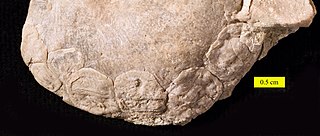
The Craniidae are a family of brachiopods, the only surviving members of the subphylum Craniiformea. They are the only members of the order Craniida, the monotypic suborder Craniidina, and the superfamily Cranioidea; consequently, the latter two taxa are at present redundant and rarely used.There are three living genera within Craniidae: Neoancistrocrania, Novocrania, and Valdiviathyris. As adults, craniids either live freely on the ocean floor or, more commonly, cement themselves onto a hard object with all or part of the ventral valve.

Strophomenida is an extinct order of articulate brachiopods which lived from the lower Ordovician period to the mid Carboniferous period. Strophomenida is part of the extinct class Strophomenata, and was the largest known order of brachiopods, encompassing over 400 genera. Some of the largest and heaviest known brachiopod species belong to this class. Strophomenids were among the most diverse and abundant brachiopods during the Ordovician, but their diversity was strongly impacted at the Late Ordovician mass extinction. Survivors rediversified into new morphologies in the Silurian, only to be impacted once again at the Late Devonian mass extinction. However, they still survived till the mid Carboniferous.
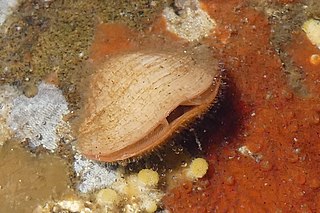
Brachiopods, phylum Brachiopoda, are a phylum of trochozoan animals that have hard "valves" (shells) on the upper and lower surfaces, unlike the left and right arrangement in bivalve molluscs. Brachiopod valves are hinged at the rear end, while the front can be opened for feeding or closed for protection. Two major categories are traditionally recognized, articulate and inarticulate brachiopods. The word "articulate" is used to describe the tooth-and-groove structures of the valve-hinge which is present in the articulate group, and absent from the inarticulate group. This is the leading diagnostic skeletal feature, by which the two main groups can be readily distinguished as fossils. Articulate brachiopods have toothed hinges and simple, vertically oriented opening and closing muscles. Conversely, inarticulate brachiopods have weak, untoothed hinges and a more complex system of vertical and oblique (diagonal) muscles used to keep the two valves aligned. In many brachiopods, a stalk-like pedicle projects from an opening near the hinge of one of the valves, known as the pedicle or ventral valve. The pedicle, when present, keeps the animal anchored to the seabed but clear of sediment which would obstruct the opening.

The origin of the brachiopods is uncertain; they either arose from reduction of a multi-plated tubular organism, or from the folding of a slug-like organism with a protective shell on either end. Since their Cambrian origin, the phylum rose to a Palaeozoic dominance, but dwindled during the Mesozoic.
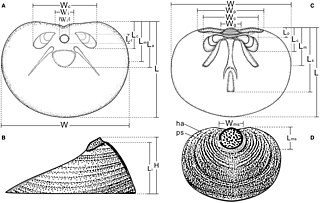
Acrotretides (Acrotretida) are an extinct order of linguliform brachiopods in the class Lingulata. Acrotretida contains 8 families within the sole superfamily Acrotretoidea. They lived from the Lower Cambrian to the Middle Devonian, rapidly diversifying during the middle Cambrian. In the upper Cambrian, linguliforms reached the apex of their diversity: acrotretides and their relatives the lingulides together comprised nearly 70% of brachiopod genera at this time. Though acrotretides continued to diversify during the Ordovician, their proportional dominance declined, as rhynchonelliforms took on a larger role in brachiopod faunas.

Rhynchonelliformea is a major subphylum and clade of brachiopods. It is roughly equivalent to the former class Articulata, which was used previously in brachiopod taxonomy up until the 1990s. These so-called articulated brachiopods have many anatomical differences relative to "inarticulate" brachiopods of the subphyla Linguliformea and Craniformea. Articulates have hard calcium carbonate shells with tongue-and-groove hinge articulations and separate sets of simple opening and closing muscles.

The Rhynchonellata is a class of Lower Cambrian to Recent articulate brachiopods that combines orders from within the Rhynchonelliformea with well developed pedicle attachment. Shell forms vary from those with wide hinge lines to beaked forms with virtually no hinge line and from generally smooth to strongly plicate. Most all are biconvex. Lophophores vary and include both looped and spiraled forms. Although morphologically distinct, included orders follow a consistent phylogenetic sequence.
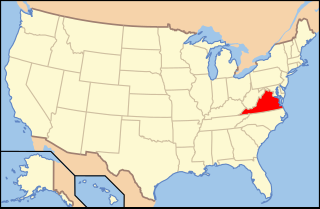
Paleontology in Virginia refers to paleontological research occurring within or conducted by people from the U.S. state of Virginia. The geologic column in Virginia spans from the Cambrian to the Quaternary. During the early part of the Paleozoic, Virginia was covered by a warm shallow sea. This sea would come to be inhabited by creatures like brachiopods, bryozoans, corals, and nautiloids. The state was briefly out of the sea during the Ordovician, but by the Silurian it was once again submerged. During this second period of inundation the state was home to brachiopods, trilobites and entire reef systems. During the mid-to-late Carboniferous the state gradually became a swampy environment.

Paleontology in Wisconsin refers to paleontological research occurring within or conducted by people from the U.S. state of Wisconsin. The state has fossils from the Precambrian, much of the Paleozoic, some a parts of the Mesozoic and the later part of the Cenozoic. Most of the Paleozoic rocks are marine in origin. Because of the thick blanket of Pleistocene glacial sediment that covers the rock strata in most of the state, Wisconsin’s fossil record is relatively sparse. In spite of this, certain Wisconsin paleontological occurrences provide exceptional insights concerning the history and diversity of life on Earth.

Paterinata is an extinct class of linguliform brachiopods which lived from the lower Cambrian ("Tommotian") to the Upper Ordovician (Hirnantian). It contains the single order Paterinida and the subfamily Paterinoidea. Despite being some of the earliest brachiopods to appear in the fossil record, paterinides stayed as a relatively subdued and low-diversity group even as other brachiopods diversified later in the Cambrian and Ordovician. Paterinides are notable for their high degree of convergent evolution with rhynchonelliform (articulate) brachiopods, which have a similar set of muscles and hinge-adjacent structures.
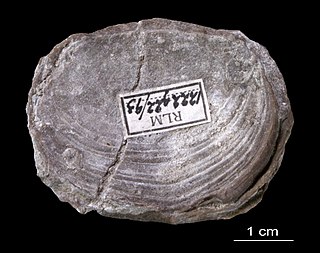
Trimerellida is an extinct order of craniate brachiopods, containing the sole superfamily Trimerelloidea and the families Adensuidae, Trimerellidae, and Ussuniidae. Trimerellidae was a widespread family of warm-water brachiopods ranging from the Middle Ordovician to the late Silurian (Ludlow). Adensuidae and Ussuniidae are monogeneric families restricted to the Ordovician of Kazakhstan. Most individuals were free-living, though some clustered into large congregations similar to modern oyster reefs.
Craniopsidae is an extinct family of craniiform brachiopods which lived from the mid-Cambrian to the Lower Carboniferous (Tournaisian). It is the only family in the monotypic superfamily Craniopsoidea and the monotypic order Craniopsida. If one includes the ambiguous Cambrian genus Discinopsis, craniopsids were the first craniiforms to appear, and may be ancestral to craniids and trimerellides. An even earlier Cambrian genus, Heliomedusa, has sometimes been identified as a craniopsid. More recently, Heliomedusa has been considered a stem-group brachiopod related to Mickwitzia.

Siphonotretida is an extinct order of linguliform brachiopods in the class Lingulata. The order is equivalent to the sole superfamily Siphonotretoidea, itself containing the sole family Siphonotretidae. Siphonotretoids were originally named as a superfamily of Acrotretida, before being raised to their own order.

Kutorginates (Kutorginata) are an extinct class of early rhynchonelliform ("articulate") brachiopods. The class contains only a single order, Kutorginida (kutorginides). Kutorginides were among the earliest rhynchonelliforms, restricted to the lower-middle part of the Cambrian Period.
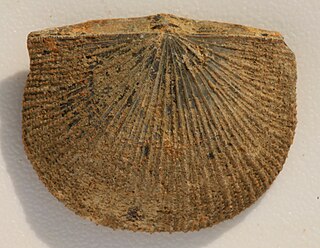
The orthotetides (Orthotetida) are an extinct order of brachiopods in the class Strophomenata. Though not particularly diverse or abundant relative to strophomenides (Strophomenida) or productides (Productida), orthotetides were nevertheless the longest-lasting order of strophomenates, surviving from the Middle Ordovician (“Llanvirn”) up until the Late Permian. Externally, many orthotetides are difficult to distinguish from strophomenides. Most fundamental differences between the two orders are internal: orthotetides have more elaborate cardinal processes and a greater diversity of shell microstructure.
Paleontology or palaeontology is the study of prehistoric life forms on Earth through the examination of plant and animal fossils. This includes the study of body fossils, tracks (ichnites), burrows, cast-off parts, fossilised feces (coprolites), palynomorphs and chemical residues. Because humans have encountered fossils for millennia, paleontology has a long history both before and after becoming formalized as a science. This article records significant discoveries and events related to paleontology that occurred or were published in the year 2019.

Rafinesquina is an extinct genus of large brachiopod that existed from the Darriwilian to the Ludlow epoch.

Leptaena is an extinct genus of mid-sized brachiopod that existed from the Dariwilian epoch to the Emsian epoch, though some specimens have been found in strata as late in age as the Tournasian epoch. Like some other Strophomenids, Lepteana were epifaunal, meaning they lived on top of the seafloor, not buried within it, and were suspension feeders.
Mesolobus is an extinct genus of brachiopod belonging to the order Productida and family Rugosochonetidae.

















